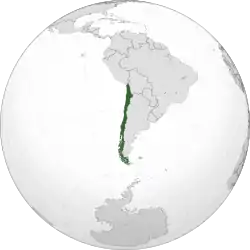Conservative Republic
In Chilean historiography, the Conservative Republic was a period of Chilean history that extended between 1826[1] and 1861, characterized by the hegemony of the conservative party, whose supporters were called pelucones. It began with the defeat of the pipiolos by the pelucones at the Battle of Lircay ending the Chilean Civil War of 1829–30 and concluded in 1861 with the election of the independent Jose Joaquin Perez as president, ending the hegemony of the conservative party.
| History of Chile |
|---|
.svg.png.webp) |
Republic of Chile República de Chile | |||||||||||
|---|---|---|---|---|---|---|---|---|---|---|---|
| 1826–1861 | |||||||||||
 | |||||||||||
| Capital | Santiago | ||||||||||
| Common languages | Spanish | ||||||||||
| Government | Presidential system | ||||||||||
| President | |||||||||||
• 1830–1831 | Jose Tomas Ovalle | ||||||||||
• 1831–1841 | Jose Joaquin Prieto | ||||||||||
• 1841–1851 | Manuel Bulnes | ||||||||||
• 1851-1861 | Manuel Montt | ||||||||||
| History | |||||||||||
| April 17 1826 | |||||||||||
• Inauguration of Jose Joaquin Perez | September 18 1861 | ||||||||||
| ISO 3166 code | CL | ||||||||||
| |||||||||||
See also
References
- Wood, James (1 January 2008). "Sotomayor Valdés, Ramón (1830–1903)". Encyclopedia of Latin American History and Culture – via HighBeam Research (subscription required) . Archived from the original on 2 August 2013. Retrieved 2 August 2013.
This article is issued from Wikipedia. The text is licensed under Creative Commons - Attribution - Sharealike. Additional terms may apply for the media files.
.svg.png.webp)
.svg.png.webp)